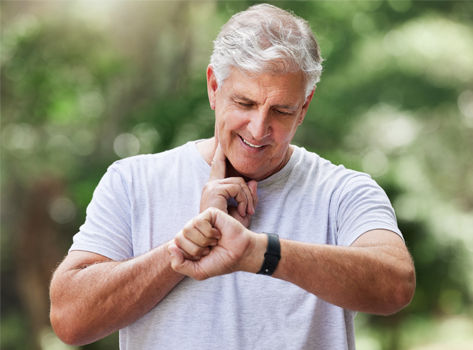
The human heart pumps an average of 2,000 gallons of blood through your body each day. The pulsing sensation you feel with each pump of your heart can tell you a lot about your overall health. Grace Zelekovic, RN, an assistant nursing manager with Atlantic Health System, shares how to check your pulse, what your heart rate can tell you and when to talk to a medical provider.
Why track your heart rate?
Your pulse is the sensation you feel when monitoring your heart rate, which is the number of times your heart beats in one minute. Monitoring your heart rate can give you information about your overall health, and Zelekovic says it’s important to know what your numbers are.
“A normal heart rate can vary significantly from person to person,” Zelekovic shares. “It’s worth taking the time to monitor your pulse every day for a week to determine what your average rate is.”
People who regularly check their heart rate may be more likely to detect conditions such as atrial fibrillation or an irregular heartbeat sooner. In addition, people with cardiac conditions or those who take certain medications may need to monitor their heart rate for dangerous variations. Zelekovic says many people choose to wear some version of a smartwatch to alert them to any changes in their heart rate.
How to check your pulse
When checking your heart rate, Zelekovic says the two easiest locations to use are your wrist and neck. The first step to checking your pulse is to make sure you are in a comfortable position and relaxed.
- To check your pulse at your wrist, extend your hand out with your palm facing the ceiling. Use your index and middle fingers to press gently onto the space below the base of your thumb.
- To take your pulse at your neck, use your index and middle fingers to press gently under your jawbone about halfway between your windpipe and the edge of your jaw.
Hold your fingers to either spot for a full minute and count the number of heartbeats you feel. You can also count the beats for 30 seconds and double that number. If you don’t feel your pulse, you can press a little harder, but Zelekovic stresses that the process shouldn’t be uncomfortable.
What is a normal heart rate?
Your heart rate is measured in beats per minute (bpm) and will vary depending on your overall health and your age. Children typically have a higher heart rate than adults.
| Birth to one month: | 70-190 bpm |
| One month to one year | 80-160 bpm |
| One year to two years | 80-13 bpm |
| Three to four years | 80-120 bpm |
| Four years to 10 years | 80-110 bpm |
| 10 years to 18 years | 60-100 bpm |
| Adults 18 years and older | 60-100 bpm |
Athletes may have a resting heart rate as low as 40 beats per minute because of regular cardiovascular exercise that strengthens their heart muscle. For people who want to calculate their target heart rate for exercise and weight loss, Zelekovic says that you can subtract your age from 220 to determine your maximum heart rate. A good goal is to be between 50% and 80% of that number.
When to see a doctor
Many factors can affect your heart rate, including medical conditions and the medications used to treat them. In addition, fever, stress, anxiety, caffeine, nicotine and diet pills can all raise your heart rate significantly.
While it’s normal for everyone to experience both high and low heart rates, Zelekovic says it’s important to speak to your medical provider if your heart rate is consistently above 110 bpm for more than a week, or if your heart rate is low and you experience symptoms including light-headedness, fainting and heart palpitations.
“You know your body better than anyone,” says Zelekovic. “Anytime you have a concern you should bring it to the attention of your doctor. It can offer you peace of mind if nothing else.”
Be Proactive About Your Health
To stay safe and healthy, it's good to have a primary care provider who knows and understands your health history and wellness goals.